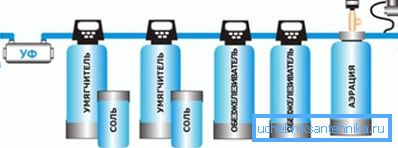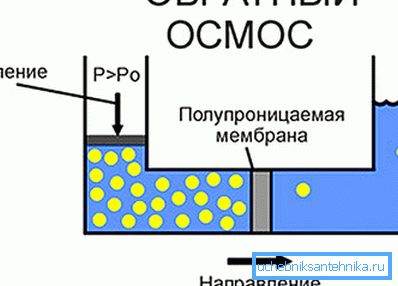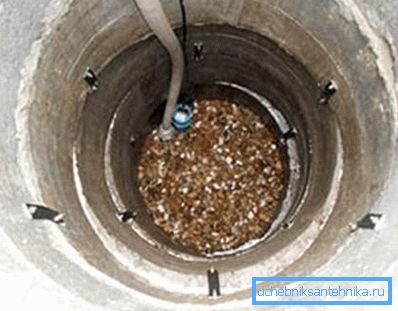The smell of water from the well: causes, ways to eliminate
Water is a chemically very active compound, a mixture of various salts, oxides, metals and other elements, and it does not smell only in a perfectly purified form.
But in nature it is generously inhabited by viruses, bacteria, other hydrobionts, and under the ground it is also saturated with salts, and these impurities affect the smell of water in the well, its color and taste.

Odor-promoting substances:
- odorants (changing the smell) appear in water when hydrogen sulfide, iron, manganese, ammonia is dissolved in the soil;
- wells and wells also pollute human waste - industrial petroleum products, chlorine;
- if the water in the well smells like a swamp, bacteria and viruses cause pollution. Earthen, fishy, putrefactive "amber" is also of natural origin.
The smell of hydrogen sulfide
Hydrogen sulfide is released during the decomposition of organic matter. For example, sulfur bacteria live in sludge, so we regularly get rid of this black sediment at the bottom of our well so that it does not stink of disgustingly rotten eggs from the well.
Cleaning methods
- Physical: if the water in the well smells of hydrogen sulfide, use the aerator for weathering. It is known that sulfur bacteria from the injection of oxygen into the well die, and water, on the contrary, is enriched with oxygen.

- Chemical: oxidizing agents - sodium hypochlorite, ozone or hydrogen peroxide for a long time will save us from hydrogen sulfide in the well.
- Mechanical cleaning: when the water from the well smells of hydrogen sulfide, apply filters with ordinary activated carbon, that is, carbon filters.

The smell of iron, manganese
Iron is a common pollutant of the springs: it would seem that their clear, transparent water gradually becomes brown, with an unpleasant metallic astringent flavor and odor.
This iron reacts with oxygen, and the result is rusty drips on the dishes and plumbing, as well as stains on laundry appear during washing. Accordingly, such a well is not suitable even for technical use.
Manganese - manganese content up to 25 mg per 1 liter still does not smell, but the water turns black from the air and a precipitate appears. Here you also need competent water purification of the well, significantly reducing its content.
Purification by filtration

- The flowing three-component system makes complex cleaning from any mechanical impurities, chlorine, organic matter, salts, heavy metal ions.
- Models Ferrum (Ferrum) also completely get rid of the dissolved iron.
- The complex (Complex) does full cleaning of any impurity and softens water too.
You should not risk and drink water directly if civilization provides us with safe and reliable filters. By the way, reverse osmosis systems are even better than cartridges, and the price of filters is low. We can use 10-inch cartridges.
Ammonia smell
Ammonia gas is less common: its sign - a strong smell of ammonia. But for us it would not be superfluous to determine the degree of hardness and acidity from sulfates, chlorides, fluorides, hydrogen sulfide and other pollutants.
Note! Modern studies have shown that ammonia, which is detrimental to us, has exceeded safe standards almost everywhere in nature, so it is necessary to filter even seemingly clean spring and well water.
Elimination
- Today, ammonium ion cleaning with impregnated carbon is popular.

- Better cleaning give special sets of organic and chemical products.
- The instruction recommends the most effective chemical elements based on conventional coal. Such an effective filter with activated carbon is preferable to other consumables in the purification of large water resources from ammonia.
- Reagents, household filters and accessories of various modifications are in specialized stores. The use of these components in the doses indicated on the packaging is guaranteed to neutralize the fetid active ammonia ions.
- Universal filters - tap or pipe nozzles eliminate this problem - and already only freshness smells of water from the well.
So, only the biochemical method completely eliminates active ions and all other harmful substances.
Cleaning the well

Preventive cleaning is needed once a year - so we will avoid trouble with water supply and health. Otherwise, mucus will inevitably appear - expanse for the rapid reproduction of bacteria, besides, debris settles to the bottom and silt falls to the bottom of the carpet, which degrades the quality of well water..
This important procedure consists of several simple steps:
- pumping water powerful pump;
- cleaning the column of the well from all sorts of deposits with their own hands mechanically;
- disinfection with special preparations exactly as directed by the instruction attached to them.

Flushing the well
- We repair with thorough repair of all holes, seams and newly formed cracks.
- We clean the bottom of debris and sludge, because the water from the well smells of hydrogen sulfide because of the accumulated sediments at the bottom.
- We install additional metal brackets that will prevent the rings from moving and prevent the column from breaking in the mine.

Tip! As a filter for the well, we can use popular natural sorbents, for example, zeolite. It is a material of volcanic origin, it provides the maximum degree of filtration from malodorous organic compounds and removes difficult metals that are difficult to eliminate.
Conclusion
For each of the substances to be removed there are indicators of their maximum content in drinking water, when they are not yet hazardous to health.
- We can improve the underground source to the required level by determining exactly why the water in the well smells unpleasant.
- Remove odorants, we can reagent and reagent-free cleaning. These are the usual redox reactions of metals in the presence of ozone, chlorine, oxygen.
- Applying the most effective methods of cleaning: aeration, filtration, coagulation (chemical cleaning), we obtain a qualitative result.
The video in this article will demonstrate to us how to solve the problem with the unpleasant smell of well water.